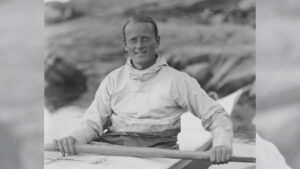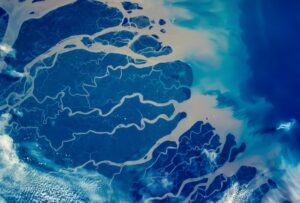BY GALYA MORRELL
The Eskimo dog, called Qimuttoq by Greenlanders, is one of the most unsung of all great explorers. It came to Greenland from distant Siberia almost 1,000 years ago, pulling heavy sleds with migrants and their belongings, a treacherous journey that few could repeat today.
The ancestors of modern Greenlanders gained their independence and ability to travel mainly because of the two revolutionary discoveries. The first was seal oil and the second was the dogsled. Both gave them the freedom to travel indefinitely across the drifting sea ice, even during long months of total darkness.
Seal oil and dogs
Seal oil and Qimuttoq explain how denizens of the Arctic thrived in the harshest climate on Earth. These ancient migrants did not depend on wood or government subsidies. They relied only on their dogs. That’s why the old Eskimos saw themselves as one being — with their dogs, tools, nature, and weather.

Ole Jorgen Hammeken and his dog team. Photo: Galya Morrell
“We are called Inuit today because we are not independent anymore,” says Inuit elder Ole Jorgen Hammeken, a prominent Greenlandic explorer, dogsledder, and actor. He played the lead role in the Greenlandic film INUK, which depicts the rapid decline of Greenlandic dogsled culture.
“Now we depend on oil, gas, money, and all other modern essentials,” he says. “We lost our knowledge and we pay the price.“
In 2007, in the frame of the International Polar Year, Hammeken led the Global Warming Dogsledding Expedition to find a new route between the towns of Uummannaq and Ilulissat in Western Greenland instead of the traditional dogsled route across Disko Bay, which no longer freezes in winter. “Because of the dogs, we were able to find the missing link,” says Hammeken.
The explorers’ best friend
Qimuttut (dogs) from Avanersuaq, also known as the Thule District, were essential to many of the arctic explorers of the 19th century — Kane, Hayes, Hall, Peary, Cook. They were also the first to go to the South Pole in 1911.
But even before that, some 4,000 years ago, Qimuttut were the first to reach the End of the World — Nunarsuup Isua Aka, the very northern tip of Greenland.
Today, Qimuttut are the only thing left from a once-rich culture. When Christian missionaries arrived in Greenland in the early 1700s, they banished all traditional ceremonial life. Drum-dancing, communal living, and spiritual beliefs in giants, dwarfs, and half-humans were outlawed. Only the dogs remained. That’s why people in Avanersuaq cling so fiercely to their dogs. Dogs are their only hope of preserving the unique culture that is quickly vanishing along with the disintegrating ice.

Photo: Galya Morrell
Today, 800 people and the same number of dogs live in Avanersuaq. The region lies just 1,000km south of the North Pole and is the only place in the world where dogsledding culture lives. Here, people still wear skins and hunt with harpoons. Dogsleds are the only means of transportation, along with small, open boats in summer. Helicopters and fixed-wing planes are available, but they are prohibitively expensive.
Snowmobiles outlawed
Thule has outlawed snowmobiles, except for fishing in Qeqertat. Fishing, traditionally frowned upon as a poor second to hunting, is on the rise because of climate change. Residents of Qaanaaq say that they noticed a sharp decline in animal life once snowmobiles were allowed further south in Greenland, in towns like Uummannaq. That’s why they chose to stick with tradition.
“A snowmobile is fast, but it is brainless,” says Rasmus Avike, one of the most experienced subsistence hunters in Qaanaaq. “It does not have eyes, it does not have ears. Dogs can smell the dangerous ice and open water and move in zigzags, but snowmobiles only go forward, often straight into disaster.”
Qimuttut are descendants of the first canine migrants that came to Greenland from Siberia via what is now the Canadian High Arctic. To keep the line pure, no one can bring other breeds into Northern Greenland. To avoid disease, if a Greenlandic dog happens to cross the Arctic Circle to the south, it is not allowed to return.

The dogs are strong but they used to be even stronger. Photo: Galya Morrell
No outside dogs allowed in northern Greenland
Even some very experienced explorers are unfamiliar with this law.
In 2013, my Inuit husband and I were in rural Siberia when we received an emergency call in the middle of the night. Russian explorer Fyodor Konyukhov had dogsledded to Greenland from the North Pole and was now hoping to cross the island from north to south in record time. His expedition patron, Dr. Arthur Chilingarov, needed our help.
Konyukhov was not allowed to enter Greenland, or rather his Russian-bred dogs from Karelia could not. Konyukhov had no idea why. Chilingarov, also known as the Tsar of the Russian Arctic, asked us to contact the Greenlandic government and try to solve the problem.
We had very little cell coverage in our small Yakutian village, but we managed to make a call from the local mayor’s office. As we expected, the answer was, “No, it’s the law!” No exceptions, even for celebrities or good causes.
Older people in Avanersuaq still remember how in the early winter of 1988, almost all the sled dogs in Northern Greenland died from a canine distemper outbreak. The virus had apparently come from Canada, then moved fast through the settlements. Eighty percent of the dogs either died or had to be killed. It was a national tragedy. Today vaccinations are done regularly, but people believe in isolation more than in vaccination.

Photo: Galya Morrell
A Qimuttoq is smart, heavy, and strong. A team can pull not just one sled but a train of them. These trains often include a small boat, a kayak, and later, an extremely heavy catch such as a narwhal, walrus, or polar bear.
They used to be stronger
“Traditionally, Eskimos used only four or five dogs per family,” says Hammeken. “That’s because, in olden days, dogs were much stronger and could pull a very heavy sled. They wandered around freely, had their hierarchy, and had natural good food. But with the arrival of Danish dog food, the dogs became more susceptible to disease and weaker in general. Now hunters sometimes need up to 20 dogs to pull the same sled.”
Qimuttut are normally fed only every second or third day in summer. They have to stay hungry so that they do not lose the instinct of survival on those long journeys when hunting goes bad. Even on hungry days, dogs must continue to pull the sled. But when the hunter gets his catch, he feeds his dogs before himself. Qimuttut can easily swallow an entire fish or medium-size pieces of whale or seal.

Photo: Galya Morrell
Their double fur coat protects them from cold
Greenlandic dogs sleep outside. Their double fur coat protects them even in extreme cold. Often in the morning, after the snowstorm, you don’t see them at all. They are buried by a thick layer of fresh snow. At dawn and at sunset they howl in unison, and there is nothing more charming than this arctic choir, heard from miles away.
Qimuttut can be as ferocious as wolves. They recognize and obey the owner who feeds them. But stay away from these dogs if you don’t know them well! They can easily bite off your hand if something is lost in translation.

Inuit kids know that puppies are okay but don’t mess with adult dogs. Photo: Galya Morrell
And yes, they can go after more than just a hand. Inuit children are usually knowledgeable enough not to become a victim of a Qimuttoq. They know the rules, and even at a very young age, they understand animal’s body language. But when young children come from the south, especially from big cities, along with their parents, the situation can go wrong very fast.
They are not pets
There was a tragedy a few years ago when a Danish child was eaten by Qimuttut. Soon after, a law was passed prohibiting dogs from wandering freely around the settlements as they had done for millennia. If an unleashed dog is spotted, the “killer-man” is called, and the dog is shot within minutes.
Because of this law, dogs are chained most of the year to the rocks or to the ice. Sometimes, they can stay chained for nine months. They get depressed. By the time the sea ice arrives, their memory of hierarchy is lost. The process has to start from the very beginning. It may take weeks of fierce fighting before an order is re-established. Then the travel season can finally begin.

A working dog, not a pet. Photo: Galya Morrell
There was a time when Qimuttut were part of sacred rituals. They were guardians of home and family, protecting the intimate relationship between the dogs and humans. In Kalaallit (Greenland Inuit) tales, women customarily married dogs and gave birth to entities with superpowers. Meanwhile, a white man –- a Qallunaaq –- was believed to be the product of an Eskimo woman impregnated by Kalaallit Qimuttoq.
Uncertain future
Today, not only tales but Kalaallit Qimuttut themselves are on the brink of extinction. Qimuttut still have the right of way on short roads within the settlements. Special road signs remind foreigners that dogs take precedence, but their future remains dim. In the last 20 years, Greenland’s sled dog population has fallen from 31,000 dogs to fewer than 15,000 today.

A vanishing life. Photo: Galya Morrell
Both climate change and westernization put the Qimuttoq’s future at risk. In most other areas where dogsledding culture once thrived, from Chukotka to Nunavut, it now exists only as a memory, a tourist attraction, or a sport.
People of Thule don’t like to talk about the bad stuff. If asked, they will draw on ancient Inuit attitudes and say, “This will pass too.”
Recently, the Greenlandic government has started a few projects to save the dogsledding culture. One of them, Qimmeq — The Greenlandic Sled Dog, is a large multidisciplinary scientific overview on sled dog culture and the genetic origins of the sled dog. A joint effort of the University of Greenland, the Natural History Museum of Denmark, and the University of Copenhagen, it aims to start a communal conversation about Inuit cultural identity. It may help sustain a viable sled dog culture for future generations.

Photo: Galya Morrell

Visual artist Galya Morrell has lived and traveled in the Arctic for over 30 years. Under the stage name ColdArtist, Galya explores the limits of the body and the possibilities of the mind, working in a rare genre of visual synthetic performance on the drifting sea ice. Together with Greenlandic polar explorer and actor, Ole Jorgen Hammeken, Galya has founded many cultural initiatives focused on the circumpolar regions.






